This is the fourth in the series of travel photography articles. See earlier articles here.
Last week we looked at how important it is to choose a suitable background while framing the shot. This week, let’s look at introducing interesting foregrounds in the image. Also, let’s look at three images that have been submitted for review this week. If you would like your images reviewed, to know what worked well in the image and how it could have been bettered, post your images on India Travel and Photography group pool on flickr and tag them as itpcritique.
CHOOSING INTERESTING FOREGROUNDS
Sometimes it is easy to get a good picture of your subjects, simply because the subject is so beautiful that you can’t go wrong. Taj Mahal is a good example. Or it could be any well known mountain or a famous waterfall. While your photograph would be just fine by itself, it may not stand out or not have any personal memories etched into the image, simply because it is just one a million shots that get taken every day. Your picture of Taj Mahal would be exactly same as the ubiquitous image taken by hundreds of people who visit the Taj, and published many times over.
A great way to pep up such images is to add some interesting foregrounds to it. The choice of foreground has to be made wisely and it must fill in just the amount frame not to distract the viewer from the main subject. Let’s look at a few examples.
The subject of the picture here is the tall ancient temples from the small village of Jageshwar in Uttarakhand. Having taken a few images of the temples already, I was looking for something that can fill life to the image. That’s when I spotted this priest sitting on the steps in front of one of the shrines. He added a lot of interestingness and life to the image of the temples.
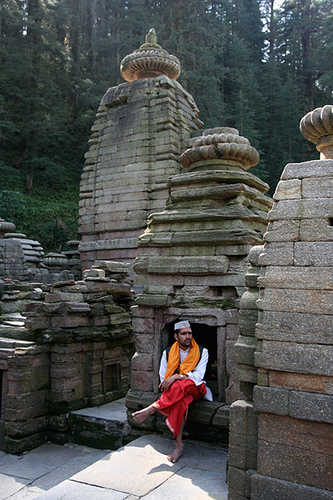
However beautiful Chandratal Lake is, I found it hard to get good images of the lake. It is a vast lake, and letting the clear lake to occupy bulk of the frame did not work very well. Its surface was very calm and reflected the sky and the mountains so well that the lake surface itself could not be seen. That’s when I thought of adding the stones in the foreground. This is what I finally got.
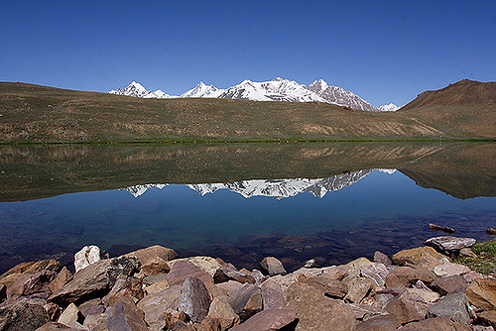
The scale and magnificence of Jog Waterfall would never have been apparent, had I not bothered to include a little bit of the cliff at the bottom of the frame. In fact, picture of the just the strands of waterfall would have left the viewer clueless about what is happening. The foreground also helps get the perspective right, and sometimes gives a sense of scale.
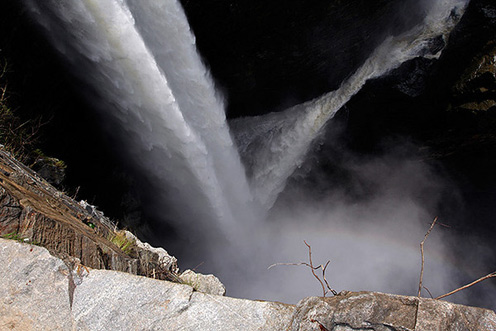
I stumbled on this image yesterday browsing through flickr, which would be a perfect example of using a foreground to enhance the image. The plant in the foreground by itself is not interesting, but greatly enhances the photograph as a whole.
To conclude, there are various ways by which a good foreground can improve the image. It could create a distraction that actually complements the image and makes it stand out from the typical. It can also make the viewer realize the scale, and help in getting the right perspective.
IMAGE REVIEWS
The two images below are posted for review by flickr users Prashanth M‘ and mridula respectively.
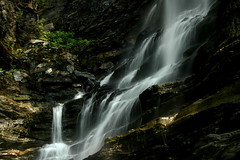
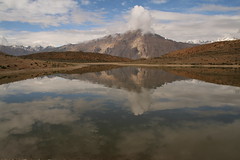
Both images are good subjects for introducing a foreground to enhance the image. While Prashanth M‘s frozen waterfall is well executed, something more to fill the bottom right portion would have improved the image. Normally, a flow looks pleasing to the eye when it moves from left to right than otherwise, but I guess such an angle would not have been possible with this waterfall. The image of lake submitted by mridula has nice reflection, and the mountains are positioned well in the image. But looking at the picture, I can’t tell how much does the lake extend to the front, and miss the scale of the entire lake. The piece of cloud sticking right on the mountain peak is also a distraction. Waiting for it to go away would have helped.
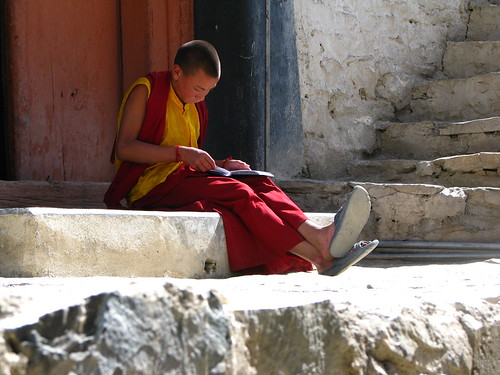
Though I was planning to review just two pictures, I could not resist posting this one, submitted by flickr user janhaviiii. A well executed image, the young monk is positioned perfectly well in the frame. The porch where he is sitting, steps leading up, the free space left in front of the monk are all that go well with the picture. The bottom portion of the image is unfortunately burnt, and is very prominent. But with the monk sitting in shadow and too much variance of brightness in the frame, this would not have been easy to prevent. One possibility to get this right would be to slightly underexpose the shot, and brighten the shadows later on the computer.
If you would like your images reviewed and know what worked well in the image and how it could have been bettered, post your images on India Travel and Photography group pool on flickr and tag them as itpcritique.
“Where is Law College?” I asked a policeman who was standing guard in front of a building. He looked bored. Without speaking a word, he lazily lifted a hand and pointed to a road to his left. Subsequent questions I asked him to reassure my directions were responded with nodding or shaking of his head. He was not in a mood to talk. A little ahead on the way, I encountered a man who was coming from the other side. His appearance made me conclude that he works in one of the many government departments nearby, and would know the area better.
“Excuse me,” I stopped him and asked, “which way to Law College?”
Without a doubt or hesitation, he pointed me in the direction exactly opposite to where the policeman had pointed me. “It is a short walk in this direction,” he told me pointing his finger, “you will find it just a little ahead this way.” I decided to trust this man instead of the cop, who I thought would be here on work and may not know the area as well as the other man. Wrong move!
We are not a country where people are comfortable saying “I don’t know.” It was a day for me to see everyone trying to be helpful and preferring not to say those three words.
On a hot summer morning in Bangalore, I got down from a city bus and started looking around for Law College. My destination was not the college itself, but ‘Indian Council of Historical Research’, which was located in the college premises. Walking past busy Mysore Bank Circle along Palace Road, I entered Bangalore University’s city office and asked a watchman for Law College. The confusing directions that I started receiving from that moment took me all over the place and had me walking for next ninety minutes, searching for the elusive ICHR.
The watchman at the gate looked at me as if I am a latecomer, and shook his head and said, “They have shifted to the university campus in Mysore Road; there is no law college here. It has been almost six months.” When I asked him if he had any clues on ICHR, he dismissed me quickly, indicating that he hasn’t heard of anything that sounds like it. Just as I retreated, another man, someone who seemed to be of authority and sitting nearby listening to our conversation, called me back. “It is this way, at the end of the road,” he told me, pointing to the large intersection just 100m away. Indeed, the law college was there and a sign said so. But there was some construction in progress, and no one seemed to be inside. I also found a locked door where a sign said ICHR. The deserted building made me believe that they have indeed packed up. Just to confirm, I walked in and looked for some signs of life.
There were two private security personnel inside, and one of them shook his head and said “no college,” even before I said anything. “What about ICHR?” I asked him, “Are they here?” Neither of the security men seemed to have any clue of what ICHR could be. When I asked if they had moved out of here, one of them pointed me to the same gate from where I was sent here. “Go inside that gate,” he told me, “you will find it in Bangalore University Campus.” He seemed confident enough that I took his words. But when I did go in and inquire with more people, no one seemed to have any clue of anything called ICHR. When I asked for directions to ‘Indian Council of Historical Research,’ a few men there looked at me as though I was speaking Greek and Latin, After some frustration, I decided to start asking for Law College, with a hope that ICHR would have moved along with law college. That is when I met the policeman and the other gentleman.
Having decided to ignore the policeman, I went in the opposite direction and asked a few more people for Law College. Some young chaps who looked like students seemed to be the right people to show me the correct directions. They looked at me as though I am lost, and asked to me head towards the area where I initially started from. After searching for some more time and finding nothing, I finally decided to trace my way back and went again into Bangalore University Campus, to give it one last try. A watchman I met inside said he is new here and has no clue. When I asked another security guard if he had any idea where the law college had moved to, he looked surprised. “They haven’t moved anywhere. It is in the same place. Classes are going on everyday.” Another contradiction. It must have been more than an hour since my search was on and I had got every possible answers to my questions except the right one.
Finally I told myself that I will go back, make a thorough inquiry at the Law College building I had stumbled earlier, and return home no matter what the outcome is. This time the private security guards were not there, but a student was studying all alone in an empty room. When I asked him if the college had moved, he replied in the negative. “They are moving next month,” he told me, indicating that the college still operated from this building. “Today is a holiday, you can come back tomorrow and it will be open.” It was a day off owing to Ambedkar Jayanti, which explained why the college was empty. The private security guards I had stumbled into earlier meant that today is a holiday, when they said “no college.” But what about ICHR? I tried to check with the student. “Do you know if ICHR operates from here?” He seemed to have no clue again, and asked me to come and check the next day.
The whole search for an hour and a half had now brought me back full circle. I went home and never returned to check! I had found an alternate source for the documents I was looking for, at the ‘Mythic Society of India’, which I had stumbled into when people sent me searching in all directions. They had in their library, everything I was looking for!
I had a fascination to the frigid continent of Antartica since my childhood days. Having read a book published by Children’s Book Trust on the southern continent in my early teens, I always dreamed of the place. The dream stays today, and is backed with a curiosity to learn about its habitat and life around it. Later, reading about Ernst Shackleton, an explorer who perished on the way to South Pole had thrilled me a few years ago. All these had faded from my radar over time, but were kicked back into life a year or so back when I stumbled into Sudhir Khandelwal’s blog, which he updated live from Antartica. His introduction on the blog says
I’m a psychiatrist by profession (treat the mentally unwell) based in Delhi, and seek adventures in the outdoors, and cultures around the world. In November 2007 I had the incredible opportunity to spend 5 months in Antarctica on a research project. This being the first live blog by an Indian from Antarctica, I wrote regulary to journal my experiences from this amazing land. I can definitely say I fell in love with Antarctica which has been described as a desolate continent and largest, coldest, windiest and whitest desert in the world. The beauty of Antarctica is unparallel and incredible as I realized soon after reaching there. I have continued to put posts on the blog on my return – a positive impact of Antarctica
His blog now has a distinction of being featured in Limca Book of Records. Head over to read more of Antartica at Himalayan Adventurer, an unlikely name for a blog from Antartica.





